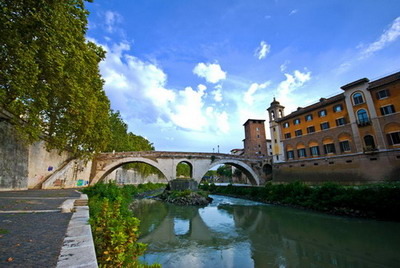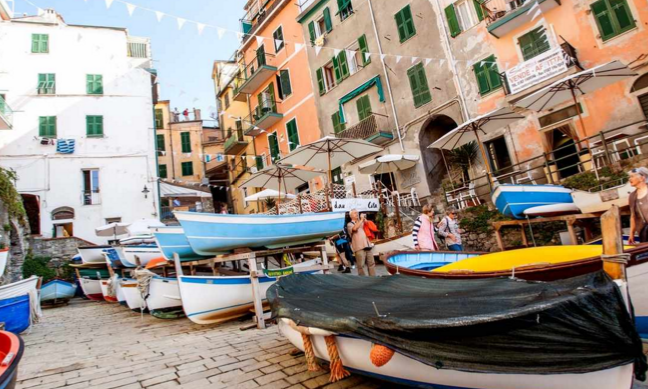
An Unforgettable Italian Journey: From Milan's Fashion to the Cinque Terre's Charm
This comprehensive travel guide outlines a classic yet rich Italian itinerary, looping from the northern powerhouse of Milan through the romantic canals of Venice, the spiritual heart of Assisi, the eternal city of Rome, the artistic treasures of Florence, and the breathtaking coastline of the Cinque Terre. Designed for travelers who wish to experience Italy's diverse offerings—urban energy, historical depth, artistic genius, culinary delights, and stunning natural beauty—this journey is a deep dive into the soul of
il Bel Paese.
1. Milan (Milano): The Gateway to Italy
Begin your adventure in Milan, Italy's global capital of fashion and finance. This metropolis is a blend of frenetic energy and profound history, offering a sophisticated start to your trip.
Main Attractions:
Duomo di Milano: The city's iconic cathedral is a masterpiece of Flamboyant Gothic architecture. Ascend to the rooftop terraces for a breathtaking, close-up view of its spires and statues against the backdrop of the city skyline.
Galleria Vittorio Emanuele II: Adjacent to the Duomo, this 19th-century arcade is one of the world's oldest shopping malls. Its magnificent glass and iron dome is a sight to behold. A local tradition involves spinning on one's heel on the mosaic bull's testicles on the floor for good luck.
Santa Maria delle Grazie: A UNESCO World Heritage site, this church houses Leonardo da Vinci's The Last Supper. Booking tickets months in advance is absolutely essential due to high demand and limited access.
Sforza Castle (Castello Sforzesco): A vast fortress that now hosts several museums and art collections, including Michelangelo's final sculpture, the Rondanini Pietà.
Food & Drink: Indulge in Milanese classics. Enjoy a creamy Risotto alla Milanese (saffron risotto), a hearty Ossobuco (braised veal shanks), and the city's signature aperitivo culture. As dusk falls, join locals for a pre-dinner drink that includes access to a buffet of snacks.
Transportation & Tips: Milan has two main airports: Malpensa (MXP) and Linate (LIN). The city center is best explored on foot and via the efficient Metro system. The Centrale station is your hub for high-speed trains to your next destinations. Purchase a Duomo rooftop ticket online to skip the long queues.
2. Sirmione and Lake Garda
A short trip from Milan brings you to the shores of Lake Garda, Italy's largest lake. Sirmione, perched on a slender peninsula, is its most famous and picturesque town.
Main Attractions:
Scaliger Castle (Rocca Scaligera): A stunning, well-preserved 13th-century castle surrounded by water, complete with a dock and defensive port.
Grotte di Catullo: The extensive ruins of a Roman villa complex located at the very tip of the peninsula. The site offers unparalleled panoramic views of the lake.
Jamaica Beach: A small, free public beach on the eastern side where you can take a refreshing dip in the crystal-clear waters of the lake.
Food & Drink: Lake Garda is known for its olive oil and fish. Try Risotto con Pesce Persico (risotto with perch) and sample local Lugana white wine. Don't miss the unique gelato flavors offered by many shops in town.
Transportation & Tips: Sirmione is easily reached by train to Desenzano del Garda/Sirmione station, followed by a short local bus ride to the town center. Note that vehicle access to the historic center is restricted; park in one of the large lots at the entrance to the peninsula and explore on foot.
3. Venice (Venezia): The Floating City
Next, journey to Venice, a city of unparalleled magic, built on over 100 small islands in a lagoon. Prepare to get lost in its maze of canals, bridges, and narrow alleyways.
Main Attractions:
St. Mark's Square (Piazza San Marco): The heart of Venice, home to St. Mark's Basilica with its golden mosaics and the Campanile (bell tower) for a bird's-eye view.
Doge's Palace (Palazzo Ducale): A masterpiece of Gothic architecture, this palace was the seat of Venetian power. Walk across the Bridge of Sighs, connecting the palace to the prisons.
Grand Canal: The main waterway of the city. Experience it by taking a vaporetto (water bus) from Piazza San Marco to Ferrovia (the train station) for a budget-friendly grand tour.
Rialto Bridge & Market: The iconic arched bridge spanning the Grand Canal. Explore the vibrant nearby market for fish, produce, and a true local atmosphere.
Food & Drink: Savor Venetian cicchetti (small snacks similar to tapas) in a traditional bacaro (wine bar). Try Sarde in Saor (sweet and sour sardines), Risi e Bisi (rice and peas), and sip on a Spritz, the quintessential Venetian aperitif.
Transportation & Tips: Upon arrival at Santa Lucia train station, you are already in Venice. The main modes of transport are walking and the vaporetto. Consider a multi-day vaporetto pass. To avoid crowds, wander away from St. Mark's Square into quieter neighborhoods like Cannaregio and Dorsoduro.
4. Rimini: Adriatic Seaside & Roman History
A shift from the lagoon to the coast, Rimini offers a blend of ancient history and modern beach culture. It's a popular Italian seaside resort with a surprising Roman past.
Main Attractions:
Tempio Malatestiano: The 15th-century cathedral, a landmark of Renaissance architecture.
Arch of Augustus (Arco d'Augusto): The oldest surviving Roman triumphal arch, dating from 27 BC.
Bridge of Tiberius (Ponte di Tiberio): A remarkably preserved Roman bridge still in use by pedestrians and cars today.
The Beach: Rimini's long, sandy coastline is lined with lidos offering umbrella and sunbed rentals for a classic Italian beach day.
Food & Drink: As part of the Emilia-Romagna region, Rimini boasts incredible food. Try piadina, a flatbread sandwich stuffed with cheese, cold cuts, and greens. Fresh seafood is abundant—don't miss a plate of brodetto, a traditional fish stew.
Transportation & Tips: Rimini is a major train station on the Adriatic line. The historic center is compact and walkable from the station. The city serves as an excellent base for exploring other nearby gems like the microstate of San Marino.
5. Assisi: The Spiritual Heart of Umbria
Journey inland to the rolling hills of Umbria to discover Assisi, the birthplace of St. Francis. This hilltop town radiates a profound sense of peace and spirituality.
Main Attractions:
Basilica di San Francesco: A UNESCO World Heritage site, this two-level basilica is adorned with magnificent frescoes by Giotto and Cimabue depicting the life of St. Francis. The lower church houses the saint's tomb.
Basilica di Santa Chiara (St. Clare): Dedicated to St. Clare, founder of the Poor Clares, it contains her remains and the famous crucifix that spoke to St. Francis.
Rocca Maggiore: A massive medieval fortress overlooking the town. The climb up is rewarded with stunning panoramic views of Assisi and the Umbrian valley.
Temple of Minerva: A beautifully preserved Roman temple facade in the main square, Piazza del Comune.
Food & Drink: Umbrian cuisine is rustic and robust. Taste strangozzi, a local hand-made pasta often served with black truffles (tartufo nero) or a spicy tomato sauce. Enjoy roasted meats (porchetta) and the region's renowned Sagrantino wine.
Transportation & Tips: The nearest major train station is in Santa Maria degli Angeli at the foot of the hill, connected to Assisi by frequent local buses. Assisi itself is best explored on foot, but be prepared for steep, cobbled streets. Dress modestly when entering the basilicas.
6. Italian Hill Town (e.g., Orvieto or Civita di Bagnoregio)
The itinerary mentions "Italian小镇" (small town) and "天空之城" (Sky City). This perfectly describes Civita di Bagnoregio, often called "The Dying Town," but we will also include Orvieto as a classic alternative.
Civita di Bagnoregio: The Sky City
The Experience: Civita is a remote, breathtaking village perched atop a eroding tuff cliff, accessible only by a long pedestrian bridge. It feels frozen in time, with its stark beauty and isolation earning it the nickname "Sky City." It's a place for atmosphere and photography rather than a long list of sights.
Transportation & Tips: You must park in the modern town of Bagnoregio and walk across the bridge. Visit early in the morning or late in the afternoon to avoid day-trip crowds and experience its magical silence.
Orvieto: The Etruscan Cliff-Top City
The Experience: A more substantial hill town, Orvieto is famous for its stunning black-and-white striped Duomo, one of Italy's greatest Gothic cathedrals. Explore its network of underground caves (Orvieto Underground) carved by Etruscans over 2,500 years ago.
Food & Drink: Orvieto is located in Umbria/Lazio border area. Enjoy its namesake white wine and wild boar (cinghiale) dishes.
7. Rome (Roma): The Eternal City
The climax of any Italian tour, Rome is a sprawling, open-air museum where millennia of history coexist with vibrant modern life.
Main Attractions:
The Colosseum & Roman Forum:The iconic symbol of ancient Rome. Book a "Full Experience" ticket online to skip the line and access the underground and upper tiers. The adjacent Roman Forum was the political and social heart of the Roman Empire.
The Vatican City:A sovereign state within Rome. Must-sees include St. Peter's Basilica (climb the dome for a spectacular view) and the Vatican Museums, home to the Sistine Chapel. Book museum tickets online well in advance.
The Pantheon:A miraculously preserved Roman temple, now a church, with the world's largest unreinforced concrete dome.
Treví Fountain & Spanish Steps:Toss a coin into the Baroque Trevi Fountain to ensure your return to Rome. Then climb the elegant Spanish Steps for a lovely vista.
Food & Drink:Cacio e Pepe and Carbonara are Rome's classic pasta dishes. Enjoy thin-crust Roman-style pizza (pizza al taglio) by the slice and supplì (fried rice balls). End your day with a gelato from a quality gelateria.
Transportation & Tips:



